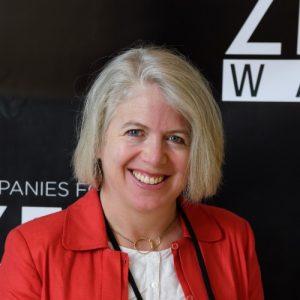Reusing and Recovering Waste: The Human Power Behind Our Progress
By Linda Qian

Intel’s sustainability journey started “officially” in 1994, when we released our first public Environmental, Health, and Safety Report. Since then, we’ve made a ton of progress; in the last three years alone, we’ve increased the reuse and recovery of our manufacturing waste by 275%! This kind of progress wouldn’t be possible without dedicated human beings pushing us forward.
Kathleen Fiehrer, a materials engineer in our supply chain organization, was particularly instrumental in these efforts. Kathleen, who has held a variety of environmentally-focused roles in the two decades she’s worked at Intel, is vehement about helping us reduce our impact, specifically around manufacturing waste. I sat down with her (virtually) to understand why she’s so passionate about sustainability.
What drives your personal passion for environmental sustainability?
Kathleen: I remember sitting in a college lecture at Seattle University and joking that the Cascades would be beachfront property due to the warming of the climate. While that was a stretch back then, it’s becoming closer to reality – new studies show that 150 million people in coastal lowlands may lose their homes to rising sea levels by the middle of this century. That’s when I decided to choose an area of study that would let me pursue an environmentally-focused career. I think we have an obligation to future generations and the responsibility of being caretakers of the globe. What’s going on with the climate is threatening our own livelihood and that of other species as well. It’s going to impact where we can live and the food we can eat.
We’re publishing a white paper about reusing and recovering materials (i.e., circular economy) at Intel, which you helped author. How did you first get involved in this work?
I got my first taste of it when I was developing waste treatment systems in the early 2000’s, but it wasn’t until I joined our supply chain organization in 2012 that I began intentionally identifying ways Intel could partner with our suppliers to move our manufacturing waste up the “waste hierarchy” towards reuse and recovery. We had just published new environmental goals, including three focused on waste, which really helped to galvanize action.
It couldn’t have been an easy journey all of the time, though. Did you face any challenges in making progress?
Of course – it doesn’t always work out, but I’ve been persistent. My management chain has been very supportive of this work, so it wasn’t an uphill battle in that respect. It definitely helped that all of the initiatives have been cost neutral or cost-saving, though that’s often dependent on location, as waste management options may vary locally. Our waste management suppliers were essential to our progress in this space; they helped us in identifying these opportunities, and as our manufacturing processes evolve, we’ll need their support to build on this momentum.
Has anything surprised you about this journey?
Our first major effort – recovering spent sulfuric acid in Arizona, which is detailed in our white paper – was the easiest and most successful, which set a good precedent. I’m also very proud of what our Ireland team has been able to achieve – in just four years, they’ve gone from zero reuse and recovery to reusing and recovering virtually all of their manufacturing waste.
I know this is just the beginning for you. What is your sustainability hope for the future – here at Intel and for other companies?
I would love to see more companies tie their compensation to the achievement of sustainability goals, like Intel has since 2009. For Intel, as we’re getting ready to publish 2030 corporate responsibility goals, I’d like us to think more holistically about what we can do across the company to reduce our environmental impact – on the front-end and back-end. True circularity will make a difference for our planet. It won’t be easy, but unless more individuals and companies start focusing on this, the planet’s changing climate will make decisions for us.
—
If you’re interested in understanding how Intel is incorporating circular economy concepts to reduce our environmental impact, read our white paper, “Circularity in Intel’s Semiconductor Manufacturing: Recovery and Reuse” or visit www.intel.com/environment.
For tips on how you can reduce your own environmental impact by recycling and reusing, check out “5 Tips to Recycle Better” by our resident dumpster diver, Taimur Burki.

